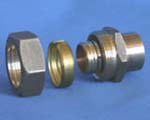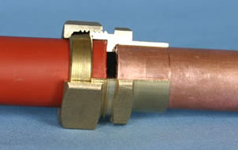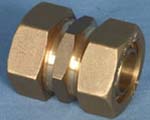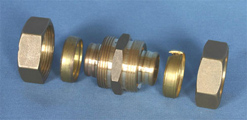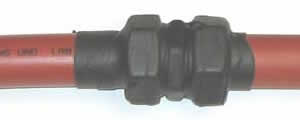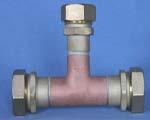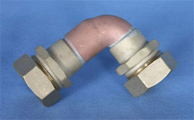Adaptors
Adaptors are the brass fittings used to connect PEX tubing to ¾” copper pipe. Since the adaptor is designed to sweat onto a stub of pipe, it can be used in conjunction with any fitting your installation demands…a copper tee, an elbow, or a coupling.
To use an adaptor, first prep the fitting for soldering by sanding and fluxing both the female end of the adaptor, and the stub of ¾” pipe it will be soldered to. Needless to say, never attach the PEX tubing to the adaptor before the soldering operation is completed.
Once the adaptor has cooled, the nut and ferrule (brass ring) on the threaded end of the adaptor can be slipped onto the PEX, then the PEX can be connected to the adaptor and the nut tightened. Some people don’t even take the nut and ferrule off the adaptor. They simply loosen the nut and carefully slip the PEX into the adaptor. Regardless of your approach, when you get the PEX inserted into the adaptor, hand tighten the nut, and then use a wrench to tighten the nut firmly.
Couplings
Obviously, since couplings are used to connect two pieces of PEX, there is no soldering involved. However, when it comes to attaching the PEX to the brass fitting, the coupling is pretty much identical to the adaptor… i.e., nut, ferrule, and tighten good and snug.
When a coupling is used to repair damaged tubing in a slab on grade application, self-vulcanizing (sticks to itself) rubber tape is wrapped around the brass coupling to protect it from the concrete.
Note: Several years ago, Radiant Floor Company used brass “barb and clamp” type fittings for both adaptor and coupling applications (see photo below). And although these fittings proved to be tight, long lasting, extremely durable, and effective, they had one main problem, i.e. compared to the fittings shown above, they were much harder to install.
Because the barbs were designed to fit VERY tightly into the PEX, in most instances a heat gun was used to soften the tubing before sliding it onto the barbs. This process consumed lots of time and labor…especially in large systems requiring dozens of connections. Add the vinyl sleeves and a multitude of hose clamps to the mix and you can appreciate the simplicity of the new fittings.
It’s not an exaggeration to say that our new adaptors and couplings install in one-tenth of the time. With no heating of the tubing and two common adjustable wrenches, the installer achieves an equal, or even superior, connection.
Imagine putting all this together AFTER spending several minutes juggling an extension cord and a heat gun. The new fittings can be assembled in one-tenth the time and require no electricity.
Other Fittings
Two other fittings bear mentioning in this section, that is, the PEX tee and the Pex elbow shown below.
PEX Tee
Needless to say, the PEX tee comes in handy when the main header feeding the circuits within the zone is PEX instead of the more commonly used 3/4″ copper. Granted, it’s much cheaper to use standard copper tees and a PEX adaptor for branching off to your circuits. But sometimes, the greater expense of using many PEX tees is justified by the flexibility of using a PEX header in difficult to access areas.
PEX Elbow
The PEX elbows are useful whenever a super tight bend is required in the system. Three examples might be: dipping under a huge beam, maneuvering through an area filled with obstructions, or running tubing in a very short joist bay where wide bends are impossible.

